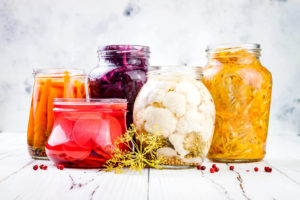Written by Ayelet Connell PhD, Natural Health Expert
Our microbiome is a frequently discussed topic today in holistic and conventional medicine. Our microbiome is essentially a mini-ecosystem of microorganisms that make up our body. This eco-system is highly populated with bacteria and fungi and viruses that call our body home. These microorganisms are vital to our immune system and gut health. When we are deficient in our ‘good bacteria’ or probiotics, essentially our army is lacking in soldiers to fight off infection.
A general wellness program often includes a daily dose of probiotics that come in the form of nutritional supplements, that are often refrigerated because these microorganisms, even through supplements, are live cultures. By taking daily probiotics, we are replenishing our microbiome. Though probiotics can be very helpful in particular to help create consistency in our diet and gut health, eating fermented foods can be hugely helpful in replenishing our gut bacteria.
There are many fun ways to add fermented foods into our diet. At natural grocers such as Whole Foods Market, you can find naturally fermented sauerkraut and kimchi (Korean fermented cabbage and other veggies) as well as other delicious fermented vegetable mixtures. When you have the time at home or you’re looking for a fun project to do at home with your kiddos, check out the recipe in this newsletter on how to make fermented foods at home. You can start with the basics such as cabbage or cucumbers and once you get your sea legs on, you can get more creative!
Some light reading…
The Microbiome Diet book was released in 2014 during the initial wave of press about the microbiome. This book does a great job at outlining the benefits of fermented foods in our diet and offers some great recipes and guidelines on how to introduce and maintain fermented foods in our daily food regimen. Check out the book and check out the following ‘very basic’ recipe on how to ferment foods at home for you and your family!

Something delicious… and healthy–Fermented Foods!
For centuries, fermented foods have been used to heal the gut and support the human immune system. There are so many variations on how to ferment our food but here is a very simple recipe. Once you’ve practiced with the basics, get creative with fresh herbs and spices to add a kick to your fermented foods!
Directions:
1. Start with fresh, organic produce. Some fan favorites include cabbage, cucumbers, beets, carrots – even apples. Place in a 1-quart glass mason jar.
2. Mix 1 1⁄2 tablespoons of sea salt (Celtic or pink Himalayan) with 1 1⁄2 cups of filtered water. Pour over the produce until just below the jar’s rim. It’s important to ensure that the veggies are completely submerged. You can add more water if needed.
3. At this point, you can also add any spices you like (dill, basil and peppercorns are great!)
4. Screw the lid on tightly and store at room temperature out of direct sunlight.
5. When you start seeing bubbles around day 2, gently loosen the lid to release some gas. Continue to do this once a day.
6. Your fermented food is ready to enjoy around day 4 or 5, but you can certainly let them go longer for a tangier flavor.
7. Once your desired taste is achieved, transfer the jar to your fridge and enjoy!
Note: Just a side note, many people use a starter culture, which is totally fine. You can usually find this as your local health food store or online. Quality sea salt works just as well though. ?
Recipe taken from paleovalley.com
Download this post: HealthyBodyHealthyHomeNewsletter3.